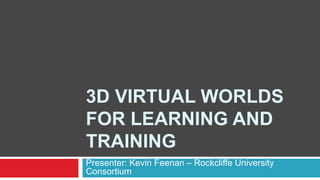3D Virtual Worlds for Learning and Training
- 1. 3D VIRTUAL WORLDS FOR LEARNING AND TRAINING Presenter: Kevin Feenan ŌĆō Rockcliffe University Consortium
- 2. Overview ’é© Introduction to Virtual worlds ’é© 3D vs 2D Concepts ’é© Use of Simulation in Education
- 3. Introduction to Virtual Worlds
- 4. MMORPG ’é© Massive Multiplayer Online Role Playing Game (MMORPG) ’é© Virtual Collaborative Environment (VCE)
- 5. Alliance vs. Horde in Eye of Storms WOW Battleground Scene
- 6. Characteristics ’é© Social ’é© Goal-Oriented ’é© Provide Challenges ’é© Experiential ’é© Real-Time ’é© Visual Interfaces ’é© Graphics Rendering ’é© Realistic models of the world ’é© High Processing Power ’é© High Bandwidth
- 7. ICT Convergence ’é© Information and Communication Technology ’éż Internet Relay Chat (IRC) ’éż Voice (VOIP) ’éż Real-Time Streaming Protocol (RTSP) ’éż P2P File Sharing ’éż Web Services
- 8. Product Placement ’é© Bounded ’é© No Ownership ’é© Limited Add-On ’é© Static ’é© Unbounded ’é© Ownership ’é© Open Standards ’é© Dynamic 3D VCE as Gaming 3D VCE as Platform
- 9. Overview of 3D vs 2D Concepts
- 10. Web 2.0 Concepts (OŌĆÖReilly) ’é© Strategic Positioning ’éż The Web as a Platform ’é© User Positioning ’éż You control your data ’é© Core Competencies ’éż Services, not packaged software ’éż Architecture of Participation ’éż Cost-Effective Scalability ’éż Remixable data sources and transformations ’éż Software above the level of a single device ’éż Harnesses collective intelligence
- 11. Comparison ’é© Britannica Online ’é© DoubleClick ’é© Newspapers ’é© Directories (taxonomy) ’é© Stickiness ’é© Wikipedia ’é© Google AdSense ’é© Blogging ’é© Tagging ("folksonomy") ’é© Syndication Web 1.0 Web 2.0
- 12. Just in Time ’é© Synchronous exchange of data and data transformations ’é© Medium is facilitated by use of Third Spaces (Constance Steinkuehler) ’é© Social Constructions / Sub-Cultures ’é© Peer-to-Peer Mentorship ’é© Truth is tainted by linguistic capital
- 14. Use of Simulation in Education
- 15. What is knowledge? ’é© Justified True Belief no longer relevant ’é© Predicated that we have knowledge of something being true ŌĆō circular logic ’é© Gettier Counter-Examples ’é© Post-Modern Analysis of relevancy
- 16. Justified Applied Belief Knowledge: ’é© A subject has knowledge of a proposition P, if and only if, there exists a paradigm D such that the subject can use D to describe how P can be resolved as being either true or false
- 17. Justified Applied Belief ’é© Truth: ’éż Subject S can be said to have knowledge of P, regardless of whether P resolves to be true or false, however S only knows that P is true, if and only if: 1. S believes P to be true (what) 2. S is justified in believing P to true (why) 3. S can apply P to produce a true outcome based the same starting conditions (how)
- 19. Internalization ’é© Perpetuation of an old or established paradigm ’é© Socialization of language to describe new problem sets and paradigms Sub-Culture Counter-Culture
- 20. Instructor Influences approximatel y ┬Į to 2/3rds of the knowledge development cycle
- 22. Learning S can apply P to produce a true outcome based the same starting conditions (how) ŌĆó Consistency of the shared context (emotive qualities) ŌĆó Ability to repeat reinforcing successful patterns of behaviour ŌĆó Ability to re-create the same set of starting conditions
- 23. 3D VCE Concepts ’é© Strategic Positioning ’éż The VW as a Crucible ’é© User Positioning ’éż You control your data transformations ’é© Core Competencies ’éż Dynamic Experiences, not packaged workshops ’éż Architecture of Language ’éż Cost-Effective Repeatability ’éż Remixable Cultures ’éż Software above the level of a single social network ’éż Harnesses collective emotional connectedness
- 25. Kevin Feenan, PMP, MBA President, Rockcliffe University Consortium kevin@urockcliffe.com Twitter: @urockcliffe Rockcliffe University Consortium is a 501c3 pending organization which focuses on science, education, and research in 3D virtual collaborative environments. About Rockcliffe
























